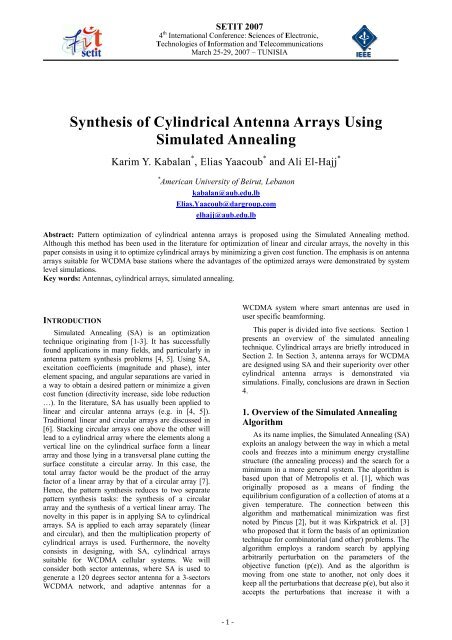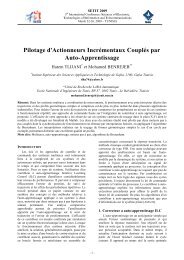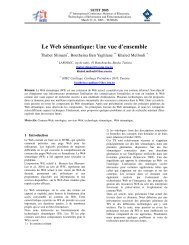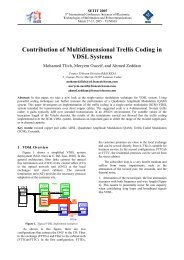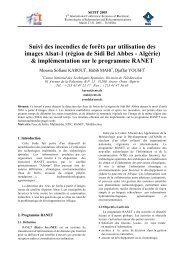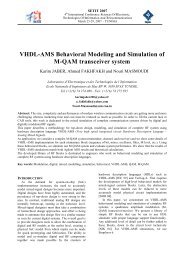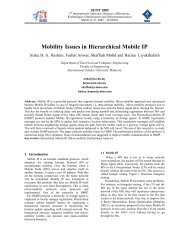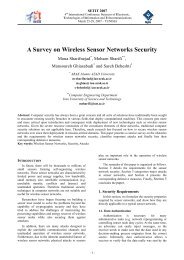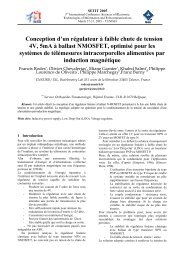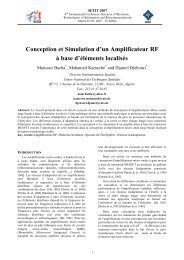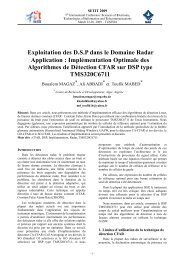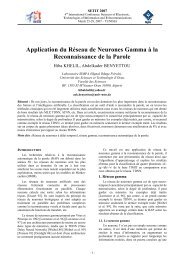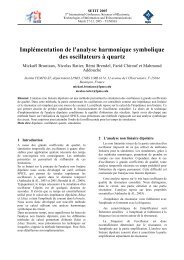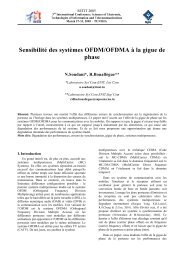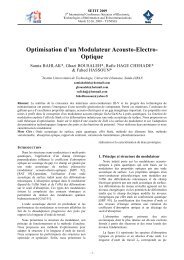Synthesis of Cylindrical Antenna Arrays Using Simulated Annealing
Synthesis of Cylindrical Antenna Arrays Using Simulated Annealing
Synthesis of Cylindrical Antenna Arrays Using Simulated Annealing
Create successful ePaper yourself
Turn your PDF publications into a flip-book with our unique Google optimized e-Paper software.
SETIT 2007<br />
4 th International Conference: Sciences <strong>of</strong> Electronic,<br />
Technologies <strong>of</strong> Information and Telecommunications<br />
March 25-29, 2007 – TUNISIA<br />
<strong>Synthesis</strong> <strong>of</strong> <strong>Cylindrical</strong> <strong>Antenna</strong> <strong>Arrays</strong> <strong>Using</strong><br />
<strong>Simulated</strong> <strong>Annealing</strong><br />
Karim Y. Kabalan * , Elias Yaacoub * and Ali El-Hajj *<br />
* American University <strong>of</strong> Beirut, Lebanon<br />
kabalan@aub.edu.lb<br />
Elias.Yaacoub@dargroup.com<br />
elhajj@aub.edu.lb<br />
Abstract: Pattern optimization <strong>of</strong> cylindrical antenna arrays is proposed using the <strong>Simulated</strong> <strong>Annealing</strong> method.<br />
Although this method has been used in the literature for optimization <strong>of</strong> linear and circular arrays, the novelty in this<br />
paper consists in using it to optimize cylindrical arrays by minimizing a given cost function. The emphasis is on antenna<br />
arrays suitable for WCDMA base stations where the advantages <strong>of</strong> the optimized arrays were demonstrated by system<br />
level simulations.<br />
Key words: <strong>Antenna</strong>s, cylindrical arrays, simulated annealing.<br />
INTRODUCTION<br />
<strong>Simulated</strong> <strong>Annealing</strong> (SA) is an optimization<br />
technique originating from [1-3]. It has successfully<br />
found applications in many fields, and particularly in<br />
antenna pattern synthesis problems [4, 5]. <strong>Using</strong> SA,<br />
excitation coefficients (magnitude and phase), inter<br />
element spacing, and angular separations are varied in<br />
a way to obtain a desired pattern or minimize a given<br />
cost function (directivity increase, side lobe reduction<br />
…). In the literature, SA has usually been applied to<br />
linear and circular antenna arrays (e.g. in [4, 5]).<br />
Traditional linear and circular arrays are discussed in<br />
[6]. Stacking circular arrays one above the other will<br />
lead to a cylindrical array where the elements along a<br />
vertical line on the cylindrical surface form a linear<br />
array and those lying in a transversal plane cutting the<br />
surface constitute a circular array. In this case, the<br />
total array factor would be the product <strong>of</strong> the array<br />
factor <strong>of</strong> a linear array by that <strong>of</strong> a circular array [7].<br />
Hence, the pattern synthesis reduces to two separate<br />
pattern synthesis tasks: the synthesis <strong>of</strong> a circular<br />
array and the synthesis <strong>of</strong> a vertical linear array. The<br />
novelty in this paper is in applying SA to cylindrical<br />
arrays. SA is applied to each array separately (linear<br />
and circular), and then the multiplication property <strong>of</strong><br />
cylindrical arrays is used. Furthermore, the novelty<br />
consists in designing, with SA, cylindrical arrays<br />
suitable for WCDMA cellular systems. We will<br />
consider both sector antennas, where SA is used to<br />
generate a 120 degrees sector antenna for a 3-sectors<br />
WCDMA network, and adaptive antennas for a<br />
WCDMA system where smart antennas are used in<br />
user specific beamforming.<br />
This paper is divided into five sections. Section 1<br />
presents an overview <strong>of</strong> the simulated annealing<br />
technique. <strong>Cylindrical</strong> arrays are briefly introduced in<br />
Section 2. In Section 3, antenna arrays for WCDMA<br />
are designed using SA and their superiority over other<br />
cylindrical antenna arrays is demonstrated via<br />
simulations. Finally, conclusions are drawn in Section<br />
4.<br />
1. Overview <strong>of</strong> the <strong>Simulated</strong> <strong>Annealing</strong><br />
Algorithm<br />
As its name implies, the <strong>Simulated</strong> <strong>Annealing</strong> (SA)<br />
exploits an analogy between the way in which a metal<br />
cools and freezes into a minimum energy crystalline<br />
structure (the annealing process) and the search for a<br />
minimum in a more general system. The algorithm is<br />
based upon that <strong>of</strong> Metropolis et al. [1], which was<br />
originally proposed as a means <strong>of</strong> finding the<br />
equilibrium configuration <strong>of</strong> a collection <strong>of</strong> atoms at a<br />
given temperature. The connection between this<br />
algorithm and mathematical minimization was first<br />
noted by Pincus [2], but it was Kirkpatrick et al. [3]<br />
who proposed that it form the basis <strong>of</strong> an optimization<br />
technique for combinatorial (and other) problems. The<br />
algorithm employs a random search by applying<br />
arbitrarily perturbation on the parameters <strong>of</strong> the<br />
objective function (p(e)). And as the algorithm is<br />
moving from one state to another, not only does it<br />
keep all the perturbations that decrease p(e), but also it<br />
accepts the perturbations that increase it with a<br />
- 1 -
SETIT2007<br />
probability p = exp( −∆f<br />
/ T) , where ∆f is the<br />
increase in f =p(e) due to the perturbation, and T is a<br />
control parameter which by analogy with the original<br />
application is<br />
known<br />
as the temperature <strong>of</strong> the system. By accepting some<br />
changes that increase f, the SA algorithm avoids being<br />
trapped in local minima. This method was applied<br />
extensively in the literature to optimize the patterns <strong>of</strong><br />
linear arrays (e.g. in [4]), and circular arrays (e.g. in<br />
[5]).<br />
Below is a listing <strong>of</strong> a version <strong>of</strong> the SA algorithm<br />
aimed to minimize an M variable function<br />
f (x1,<br />
x 2,<br />
⋅⋅⋅,<br />
x M ) over R<br />
M .<br />
Step 1: T = T 0<br />
x i = x i0 i = 1,…, M<br />
A = f(x 10 ,…, x M0 )<br />
k = 0<br />
Step 2: AcceptedCounter = 0<br />
AttemptedCounter = 0<br />
Step 3: Choose a random integer number r between 1<br />
and M<br />
Choose a random perturbation ∆x<br />
B = f(x 1 ,…, x r + ∆x,…, x M )<br />
AttemptedCounter AttemptedCounter + 1<br />
If B ≤ A then<br />
x r x r + ∆x<br />
B A<br />
k = 0<br />
AcceptedCounter AcceptedCounter + 1<br />
Else choose u a random real number in [0, 1]<br />
If u ≤<br />
e<br />
⎛ ( B−<br />
A)<br />
⎞<br />
⎜ − ⎟<br />
⎝ T ⎠<br />
then<br />
x r x r + ∆x<br />
B A<br />
k = 0<br />
AcceptedCounter AcceptedCounter + 1<br />
Step 7: If k < Criterion3 then go to Step 2<br />
Step 8: The End<br />
Note that:<br />
The initial temperature T 0 must be set at a high<br />
value in order to guarantee acceptance <strong>of</strong> any system<br />
perturbation at the beginning.<br />
The temperature is decreased during the algorithm<br />
(Step5), and no optimal decreasing strategy for T is<br />
yet found. Anyway, the most common and simple rule<br />
is T k+1 =α T k ( 0
SETIT2007<br />
AF<br />
circular<br />
N<br />
n=<br />
1<br />
( [sinθ cos( ϕ− ϕ )] + α )<br />
j kr<br />
n n<br />
( θϕ , ) = ∑ I e<br />
(2)<br />
In (2), “r” is the radius, I n are the excitation<br />
coefficients, α n are the excitation phases, and φ n is the<br />
angle in the x-y plane between the x-axis and the n th<br />
element.<br />
Stacking circular arrays one above the other, with<br />
an equal vertical separation between them, will lead to<br />
a cylindrical array where the elements along a vertical<br />
line on the cylindrical surface form a linear array, and<br />
those lying in a transversal plane cutting the surface<br />
constitute a circular array as illustrated in Figure 1.<br />
Figure 1. <strong>Cylindrical</strong> Array.<br />
In this case, the total array factor would be the<br />
product <strong>of</strong> the array factor <strong>of</strong> a linear array by that <strong>of</strong> a<br />
circular array [7]. The array factor <strong>of</strong> one circular<br />
array in the x-y plane is given by (2), and the array<br />
factor <strong>of</strong> a linear array on the z axis is given by (1).<br />
n<br />
c<br />
jα<br />
n ( kd cos m )<br />
( )<br />
j m θ + β<br />
nm<br />
θ I<br />
ne<br />
⋅ bme<br />
In (4), the term<br />
= (4)<br />
b<br />
m<br />
exp( jκd<br />
cosθ + β<br />
comes<br />
from the m<br />
th vertical element and Inex(<br />
jα n ) is the<br />
excitation coefficient <strong>of</strong> the n th element <strong>of</strong> a circular<br />
array. Substituting (4) into (3), it becomes:<br />
m<br />
M<br />
N<br />
j( kdmcos θ+ βm) jαn jkrsinθcos( ϕ−ϕn)<br />
∑ m ∑ n<br />
m= 1 n=<br />
1<br />
AF( θϕ , ) = b e I e e<br />
=<br />
M<br />
N<br />
jkd ( mcos θ+<br />
βm)<br />
∑be<br />
m ∑ n<br />
m= 1 n=<br />
1<br />
= AF ( θϕ , ) ⋅AF<br />
( θϕ , )<br />
linear<br />
circular<br />
Ie<br />
m<br />
)<br />
jkr { sinθcos( ϕ− ϕ ) + α }<br />
n<br />
(5)<br />
It is evident from (5) that the array factor <strong>of</strong> a<br />
cylindrical array is equivalent to the multiplication <strong>of</strong><br />
the array factors <strong>of</strong> a linear array by that <strong>of</strong> a circular<br />
array. Hence, the pattern synthesis reduces to two<br />
separate pattern synthesis tasks: the synthesis <strong>of</strong> a<br />
circular array and the synthesis <strong>of</strong> a vertical linear<br />
array.<br />
3. <strong>Simulated</strong> <strong>Annealing</strong> Applied to<br />
<strong>Cylindrical</strong> <strong>Antenna</strong> <strong>Arrays</strong><br />
<strong>Using</strong> SA, excitation coefficients (magnitude and<br />
phase), inter element spacing, and angular separations<br />
are varied in a way to obtain a desired pattern or<br />
minimize a given cost function (directivity increase,<br />
side lobe reduction, pattern nulling, pattern shaping,<br />
…). Figure 2 shows, as an example, the result <strong>of</strong><br />
optimizing a 10 element linear array with Chebychev<br />
excitations and 20 dB side lobe level (sll) to obtain a<br />
null at 50 degrees.<br />
n<br />
<strong>Using</strong> a cylinder <strong>of</strong> M identical circular arrays, and<br />
with the help <strong>of</strong> (1) and (2), the total array factor is<br />
given by the sum <strong>of</strong> the M individual array factors:<br />
0<br />
-5<br />
-10<br />
initial<br />
SA<br />
AF(<br />
θ,<br />
ϕ)<br />
=<br />
M<br />
∑∑<br />
m=<br />
1<br />
⎡<br />
⎢<br />
⎣<br />
N<br />
n=<br />
1<br />
c<br />
nm<br />
( θ ) e<br />
jkr sinθ<br />
cos( ϕ −ϕn<br />
)<br />
⎤<br />
⎥<br />
⎦<br />
(3)<br />
In (3), we consider that in the far field region, the<br />
array factor <strong>of</strong> each circular array is the same as the<br />
array factor <strong>of</strong> the circular array in the x-y plane.<br />
However, the vertical distribution <strong>of</strong> the elements<br />
introduces a phase difference between the circular<br />
arrays identical to the phase difference between the<br />
elements <strong>of</strong> a linear array, since the elements along the<br />
vertical direction constitute a linear array. Hence, in<br />
(3):<br />
Array Factor (dB)<br />
-15<br />
-20<br />
-25<br />
-30<br />
-35<br />
-40<br />
-45<br />
-50<br />
0 20 40 60 80 100 120 140 160 180<br />
theta<br />
Figure 2. Approximating a Chebyshev <strong>Antenna</strong><br />
Pattern with 20 dB sll and a Null at 50 degrees.<br />
In fact, the solid curve shows that the array<br />
obtained by SA approximates well the Chebyshev<br />
- 3 -
SETIT2007<br />
array, in addition to having a null at 50 degrees. The<br />
optimized parameters and the cost function are shown<br />
in Table 1.<br />
Table 1. Parameters Obtained after SA optimization<br />
<strong>of</strong> a 10 element Chebyshev Linear Array with 20 dB<br />
sll to Obtain a Null at 50 Degrees.<br />
Element No. 1 2 3 4 5<br />
Excitation<br />
Coefficients 1.15 1.36 1.34 1.22 1.57<br />
Excitation<br />
Phases<br />
(degrees)<br />
9 0 3 3 358<br />
Figure 3. Array Factor Magnitude <strong>of</strong> a Sector<br />
<strong>Antenna</strong> Generated by SA.<br />
Distances<br />
from the<br />
Origin (in<br />
wavelengths)<br />
Element<br />
No.<br />
-<br />
2.36<br />
-1.75 -1.21 -0.75 -0.27<br />
6 7 8 9 10<br />
Excitation<br />
Coefficients 1.76 1.39 0.55 1.11 1.03<br />
Excitation<br />
Phases<br />
(degrees)<br />
Distances<br />
from the<br />
Origin (in<br />
wavelengths)<br />
356 359 61 338 5<br />
0.23 0.78 1.29 1.36 1.97<br />
Table 2. Parameters Obtained after SA optimization<br />
<strong>of</strong> a 10 element Circular Array to Obtain a Sector<br />
<strong>Antenna</strong> for WCDMA.<br />
Element No. 1 2 3 4 5<br />
Excitation<br />
Coefficients 0.21 0.3 0.06 0.85 0.75<br />
Excitation Phases<br />
(degrees)<br />
Angle φ n (degrees)<br />
5 188 337 358 157<br />
0 5 71 214 219<br />
Element No. 6 7 8 9 10<br />
Cost Function<br />
π<br />
∫ ( | ( θ)| |<br />
desired<br />
( θ)| ) θ 100 ( | (50)| |<br />
desired<br />
(50)|)<br />
0<br />
2 2<br />
Cost = AF − AF d + AF − AF<br />
Excitation<br />
Coefficients 0.6 1.34<br />
Excitation Phases<br />
(degrees)<br />
-<br />
0.71<br />
1.45 0.38<br />
291 349 232 144 336<br />
Initial (Starting) Array<br />
10 element linear Chebychev with 20 db sll and inter element<br />
spacing d = 0.5 λ<br />
Angle φ n (degrees)<br />
Cost Function<br />
232 263 269 282 288<br />
The importance <strong>of</strong> the null at 50 degrees is<br />
emphasized by the factor 100 in the cost function. In<br />
Figure 3, a 10 element circular array is optimized to<br />
cover a 120 degree sector in a wireless system. The<br />
obtained parameters are shown in Table 2.<br />
2π<br />
∫ ( | ( θ 90, ϕ)| |<br />
desired<br />
( θ 90, ϕ)|<br />
)<br />
Cost = AF = − AF = dϕ<br />
0<br />
Initial (Starting) Array<br />
10 element uniform circular array with radius r = 1 λ and<br />
the main beam steered at max at θ = 90, φ = 0<br />
2<br />
Stacking circular arrays one above the other will<br />
lead to a cylindrical array where the elements along a<br />
- 4 -
SETIT2007<br />
vertical line on the cylindrical surface form a linear<br />
array and those lying in a transversal plane cutting the<br />
surface constitute a circular array. In this case, the<br />
total array factor would be the product <strong>of</strong> the array<br />
factor <strong>of</strong> a linear array by that <strong>of</strong> a circular array [7].<br />
Applying this approach to the arrays <strong>of</strong> Figures 2 and<br />
3 will lead to a cylindrical array that has a sector<br />
pattern in the azimuth plane (same normalized pattern<br />
as that <strong>of</strong> the circular antenna <strong>of</strong> Figure 3) and a Null<br />
at 50 degrees in the elevation plane, as shown in<br />
Figure 4.<br />
demonstrated below.<br />
In Figure 5, a 10 element circular array is<br />
optimized by using SA to generate an array suitable<br />
for being used in WCDMA base stations as a smart<br />
antenna. The parameters <strong>of</strong> the obtained array are<br />
shown in Table 3. In the cost function, the first term<br />
corresponds to approximating the solid curve <strong>of</strong><br />
Figure 5, the second term corresponds to keeping the<br />
sll below the constant part <strong>of</strong> the solid curve, and the<br />
third term corresponds to increasing the peak value <strong>of</strong><br />
the array factor as much as possible.<br />
Figure 4. Array Factor Magnitude <strong>of</strong> a <strong>Cylindrical</strong><br />
<strong>Antenna</strong> Array Obtained by Combining the <strong>Arrays</strong> <strong>of</strong><br />
Figs. 2 and 3 in the Plane φ = 180 degrees.<br />
Hence, the pattern synthesis reduces to two<br />
separate pattern synthesis tasks: the synthesis <strong>of</strong> a<br />
circular array and the synthesis <strong>of</strong> a vertical linear<br />
array. The novelty in this paper is in applying SA to<br />
each array separately, then using the multiplication<br />
property <strong>of</strong> cylindrical arrays. Although one might<br />
argue that applying SA directly to the cylindrical array<br />
would lead to more degrees <strong>of</strong> freedom, and hence<br />
better results, using this approach would not allow<br />
making use <strong>of</strong> the multiplication property <strong>of</strong><br />
cylindrical arrays. In fact, if we consider the<br />
cylindrical array as an array <strong>of</strong> P elements instead <strong>of</strong> a<br />
linear array with M elements, each element being a<br />
circular array <strong>of</strong> N elements, and SA is applied by<br />
allowing the location <strong>of</strong> each <strong>of</strong> the P elements to be<br />
varied, the final disposition <strong>of</strong> the elements would still<br />
be on a cylindrical surface, but their disposition in a<br />
plane will not be a circular array, and their disposition<br />
along a vertical line will not be a linear array. Hence,<br />
the multiplication property would be lost. Although<br />
this approach deserves further investigation and is<br />
under current research, a much simpler one is<br />
presented here: instead <strong>of</strong> having a problem <strong>of</strong><br />
complexity P = M x N, it is reduced to two problems<br />
<strong>of</strong> complexities M and N, respectively. Hence, the<br />
total complexity would be M+N. This reduction is<br />
very useful when combined with careful design <strong>of</strong> the<br />
patterns <strong>of</strong> the linear and circular arrays constituting<br />
the cylindrical array, in order to take advantage <strong>of</strong> the<br />
pattern multiplication property, as will be<br />
Figure 5. Array Factor Magnitude <strong>of</strong> a Circular<br />
<strong>Antenna</strong> Array Designed <strong>Using</strong> SA to be Used as a<br />
Smart <strong>Antenna</strong>.<br />
Table 3. Parameters Obtained after SA optimization<br />
<strong>of</strong> a 10 element Circular Array to Obtain a Smart<br />
<strong>Antenna</strong> for WCDMA.<br />
Element No. 1 2 3 4 5<br />
Excitation<br />
Coefficients 1.26 2.83 2.61 2.13 2.48<br />
Excitation Phases<br />
(degrees)<br />
Angle φ n<br />
(degrees)<br />
108 74 205 274 343<br />
0 100 117 156 182<br />
Element No. 6 7 8 9 10<br />
Excitation<br />
Coefficients 1.49 1.83 1.92 1.87 2.12<br />
Excitation Phases<br />
(degrees)<br />
Angle φ n<br />
(degrees)<br />
32 175 277 64 73<br />
217 240 288 314 344<br />
- 5 -
SETIT2007<br />
Cost Function<br />
2π<br />
∫ (<br />
Cost = | AF( θ = 90, ϕ)| − | AF ( θ = 90, ϕ)|<br />
dϕ<br />
0<br />
ϕ2<br />
∫ ( | ( 90, ) |<br />
desired<br />
( 90, ))<br />
ϕ1<br />
− | AF( θ = 90, ϕ = 0) |<br />
desired<br />
+ AF θ = ϕ − AF θ = ϕ dϕ<br />
[φ 1 , φ 2 ]: range <strong>of</strong> values where the solid curve is<br />
constant<br />
Initial (Starting) Array<br />
10 element uniform circular array with radius r = 1 λ<br />
and the main beam steered at max at θ = 90, φ = 0<br />
)<br />
2<br />
Table 4. Parameters Obtained after SA optimization<br />
<strong>of</strong> a 3 element Chebyshev Linear Array with 20 dB sll<br />
to Approximate the peak at 90 degrees <strong>of</strong> a 10 Element<br />
Chebyshev Linear Array with 20 dB sll.<br />
Element<br />
No.<br />
Excitation<br />
Coefficients<br />
Excitation<br />
Phases<br />
(degrees)<br />
Distances<br />
from the<br />
Origin (in<br />
wavelengths)<br />
1 2 3<br />
2.42 -2.88 2.61<br />
292 112 292<br />
-2.90 -2.21 -1.51<br />
To increase the directivity, three <strong>of</strong> the circular<br />
array <strong>of</strong> Figure 5 are stacked to obtain a cylindrical<br />
array. The linear array in the vertical direction is<br />
optimized with SA, to approximate the pattern <strong>of</strong> a<br />
Chebyshev linear array with 10 elements and 20 dB<br />
sll. The result shown in Figure 6 can be considered as<br />
very good for a 3 element array approximating the<br />
pattern <strong>of</strong> a 10 element array! The optimized<br />
parameters and the cost function are shown in Table 4.<br />
Combining the arrays <strong>of</strong> Figures 5 and 6, a<br />
cylindrical array with 30 elements is obtained. It has<br />
the same normalized pattern in the azimuth plane as<br />
that <strong>of</strong> the array <strong>of</strong> Figure 5.<br />
Cost Function<br />
π<br />
∫ ( | ( θ) | |<br />
desired<br />
( θ) | ) θ 10 ( |<br />
desired<br />
(90) | | (90) | )<br />
0<br />
2 2<br />
Cost = AF − AF d + AF − AF<br />
Initial (Starting) Array<br />
3 element linear Chebychev with 20 db sll and inter<br />
element spacing d = 0.64 λ<br />
However, in the elevation plane, the multiplication<br />
property led to concentrating the radiated power in the<br />
azimuth plane, as shown in Figure 7.<br />
Figure 6. Array Factor Magnitude <strong>of</strong> a Linear<br />
<strong>Antenna</strong> Array Designed <strong>Using</strong> SA to approximate<br />
the Pattern <strong>of</strong> a 10 Element Chebyshev Linear Array<br />
with 20 dB sll.<br />
Figure 7. Array Factor Magnitude <strong>of</strong> the <strong>Cylindrical</strong><br />
<strong>Antenna</strong> Array Obtained by combining the <strong>Arrays</strong> <strong>of</strong><br />
Figs. 5 and 6 Compared to that <strong>of</strong> the Circular Array<br />
<strong>of</strong> Fig. 5 in the Plane φ = 0.<br />
This cylindrical array is used to simulate the<br />
downlink user capacity in a WCDMA cellular system<br />
using the same approach presented in [7]. The results<br />
are compared to those obtained by using the<br />
- 6 -
SETIT2007<br />
cylindrical arrays <strong>of</strong> [7] in Figure 8.<br />
in the azimuth plane. Hence, using SA, we designed a<br />
cylindrical array that led to considerable improvement<br />
in the downlink user capacity <strong>of</strong> a WCDMA cellular<br />
system, although compared to arrays having three<br />
times more elements!<br />
However, it should be noted that beam broadening<br />
and side lobe level increase due to steering were not<br />
taken into account in the capacity simulations, i.e. the<br />
pattern <strong>of</strong> the array designed with the SA method was<br />
assumed unaltered when the beam is steered toward<br />
the desired user. The other arrays in the simulation<br />
have 360 degrees symmetry in the azimuth plane [7],<br />
and consequently don’t have this problem.<br />
Figure 8. Capacity vs. Maximum Base Station Power<br />
for Various <strong>Antenna</strong> Configurations.<br />
The simulated system is a symmetric network <strong>of</strong><br />
equivalently equipped base stations, i.e., all the sectors<br />
are deployed with identical advanced antennas. It<br />
consists <strong>of</strong> 7 hexagonal cells, and takes into account<br />
path loss and shadow fading, i.e., fast fading is<br />
assumed to be averaged out by perfect power control.<br />
System functions such as s<strong>of</strong>t and s<strong>of</strong>ter handover are<br />
implemented in the model; a user located at a distance<br />
greater than 80% <strong>of</strong> the radius <strong>of</strong> the cell from the<br />
base station is considered in s<strong>of</strong>t handover. It is in<br />
s<strong>of</strong>ter handover when the angle at the base station<br />
between this user and the boundary <strong>of</strong> the neighboring<br />
sector is less than 10˚. The simulation parameters are<br />
given in Table 5.<br />
Table 5. Simulation Parameters.<br />
Parameter<br />
Value<br />
Propagation model K = -50 dB, n = 4<br />
Chip rate<br />
Portion <strong>of</strong> downlink power<br />
allocated for traffic channels<br />
3.84Mcps<br />
0.8<br />
Orthogonality factor 0.4<br />
Noise spectral density (N o )<br />
Active set size 2<br />
E b /I 0 target<br />
Standard deviation for shadowing<br />
σ<br />
Speech Rate<br />
-169dBm/Hz<br />
7.6dB<br />
8dB<br />
Number <strong>of</strong> Iterations 100<br />
8 kbps/sec<br />
In Figure 8, Array1, Array2, and Array3<br />
correspond to 99 element cylindrical arrays having,<br />
respectively, uniform, Chebyshev, and Bessel patterns<br />
4. Conclusion<br />
The <strong>Simulated</strong> <strong>Annealing</strong> optimization technique<br />
was applied to the pattern synthesis problem <strong>of</strong><br />
cylindrical antenna arrays. The process is divided into<br />
two optimization problems: one for linear arrays and<br />
one for circular arrays, then the multiplication<br />
property <strong>of</strong> cylindrical arrays is used. Obtaining good<br />
results with SA separately for linear and circular<br />
arrays led to obtaining good results with cylindrical<br />
antenna arrays. The emphasis was on arrays designed<br />
for WCDMA cellular systems. Simulations<br />
demonstrated that the cylindrical array obtained with<br />
SA led to an increase in user capacity, when compared<br />
to cylindrical arrays having three times more antenna<br />
elements, in the case <strong>of</strong> smart antennas deployed in a<br />
WCDMA cellular system.<br />
REFERENCES<br />
[1] N. Metropolis, A.W. Rosenbluth, M. N. Rosenbluth,<br />
A.H. Teller, and E. Teller, “Equations <strong>of</strong> State<br />
Calculations by Fast Computing Machines”, J. Chem.<br />
Phys. 21, 1087- 1092, 1958.<br />
[2] M. Pincus, “A Monte Carlo Method for the Approximate<br />
Solution <strong>of</strong> Certain Types <strong>of</strong> Constrained Optimization<br />
Problems”, Oper. Res. 18, 1225-1228, 1970.<br />
[3] S. Kirkpatrick, C. D. Jr. Gerlatt, and M.P. Vecchi,<br />
“Optimization by <strong>Simulated</strong> <strong>Annealing</strong>”, Science 220,<br />
671-680, 1983.<br />
[4] V. Murino, “<strong>Simulated</strong> annealing approach for the<br />
design <strong>of</strong> unequally spaced arrays,” in ICASSP<br />
International Conference on Acoustics, Speech, and<br />
Signal Processing, vol. 5, (Detroit, USA), pp. 3627–<br />
3630, 1995.<br />
[5] F. Ares, S.R. Rengarajan , J.A.F. Lence, A. Trastoy and<br />
E. Moreno, "<strong>Synthesis</strong> <strong>of</strong> antenna patterns <strong>of</strong>. circular<br />
arc arrays," Electronics Letters, vol. 32, pp. 1845-1846,<br />
Sept. 1996.<br />
[6] C. A. Balanis, <strong>Antenna</strong> Theory and Design, 2nd edition,<br />
John Wiley & Sons, 1997.<br />
[7] E. Yaacoub, K. Y. Kabalan, A. El-Hajj, and A. Chehab,<br />
“<strong>Cylindrical</strong> <strong>Antenna</strong> <strong>Arrays</strong> for WCDMA Downlink<br />
Capacity Enhancement”, IEEE ICC 2006.<br />
- 7 -


